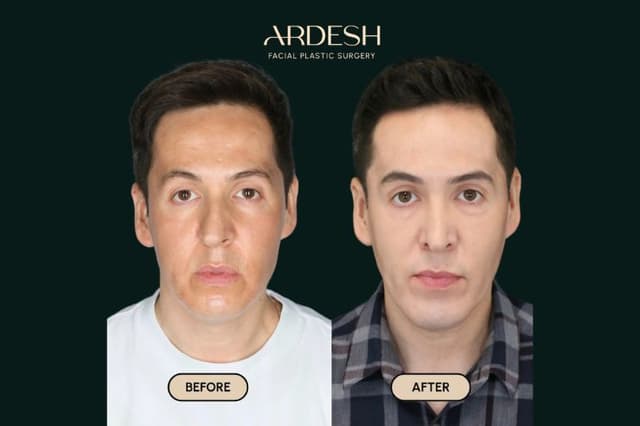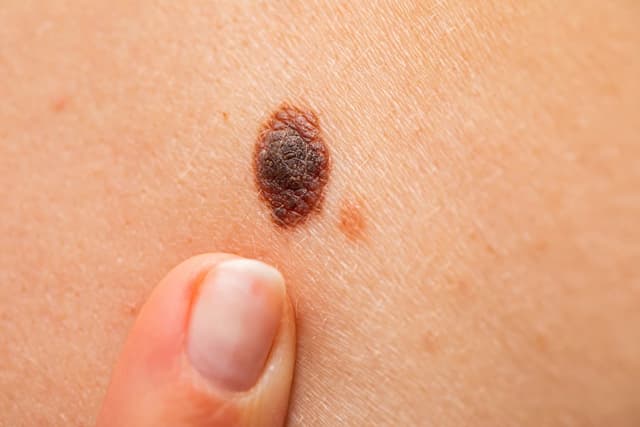If you have a flat mole, you may have considered mole removal. Though these moles are typically harmless, you might have cosmetic reasons for removal, such as wanting to create smooth, healthy skin. In other cases, having flat moles removed is medically necessary. Fortunately, The Mole Doctor TM, Dr. Ardesh, can answer any questions you may have about removing flat moles.
At The Beauty Mark Doctor TM, we’ll delve into the different mole removal treatments and at-home remedies, as well as how to identify the characteristics of flat moles.
The Characteristics of Flat Moles
Not sure if you’re looking at a flat mole? You can tell if a mole falls under this category if it has these characteristics:
- Appearance: Flat moles lie flush with the skin’s surface, often appearing as small, brown spots.
- Color: They can vary in color, ranging from light brown to dark brown or black.
- Size: Flat moles are generally smaller in size compared to raised moles, with a diameter of less than 6 millimeters.
- Shape: They can have irregular shapes, but typically have an even and smooth surface
Types of Flat Moles
Before any professional considers removing moles, they must first examine the nature of said mole. While most flat moles are benign, they can still harbor dangerous cancer cells in rare instances. Proper examination is always the first step before any mole removal surgery procedure.
- Benign Moles: Typically harmless and non-cancerous, these moles pose no immediate threat to your health and can easily undergo cosmetic mole removal.
- Atypical Moles: Also known as dysplastic nevi, atypical moles have irregular shapes and may resemble melanoma. While often benign, they should be monitored closely or removed when necessary.
- Cancerous Moles: These moles harbor melanoma, a type of skin cancer that can develop within the mole tissue and surrounding skin. Melanoma is rare in flat moles, but should still be ruled out before the removal process begins.
Removing a Flat Mole: Mole Removal Procedures
If you want to remove moles on your body, a mole removal procedure is the best way to do so. More effective than mole removal creams and other home remedies, these procedures range from minimally invasive techniques for cosmetic removals, to more extensive treatments for cancerous moles.
Laser Mole Removal
A very effective and affordable method for removing flat, skin surface moles, laser treatment involves using a laser to break down and fade unwanted pigments. It’s a non-invasive treatment option commonly used for cosmetic reasons. Laser removal is not a reliable treatment option for cancerous moles, as the concealed mole cannot be easily examined for melanoma post-treatment. For that reason, surgeons will only perform this treatment when they’re 100% sure a mole isn’t cancerous.
Cryotherapy with Liquid Nitrogen
While less common for flat moles and more popular with raised moles, this treatment involves the use of liquid nitrogen to freeze and remove moles. The skin cells in a flat mole removal can be removed, however, larger moles and skin tags will freeze and fall off more easily. Overall, this is a quick and inexpensive treatment, but does come with a risk of scarring and depigmentation.
Radiofrequency surgery
Highly effective for flat moles located in sensitive areas like the face, radiofrequency surgery uses an electric current to remove the mole. This treatment is typically more expensive than the previous two mentioned but is also fast and easy with less scarring.
Shave Excision
Suitable for a smaller, non-cancerous mole, this method involves shaving off the mole while leaving the surrounding skin intact. Being the less invasive of the excision procedures, these options are often chosen for the cosmetic removal of flat moles and are not suitable for abnormal moles associated with skin cancer.
Surgical Excision
While rare in the case of flat moles, suspicious or cancerous moles may require a surgical excision. This surgical procedure entails cutting the mole and surrounding tissue away from the skin and stitching the incision while the patient is under local anesthesia. After removal, the mole is often used to conduct a skin biopsy, allowing medical professionals to assess its nature. This is generally the most expensive option but may be covered by your insurance.
At-Home Remedies For Flat Moles
If your mole has been examined by a dermatologist and shows no signs of melanoma, there are a few at-home remedies you can try to fade flat moles. Keep in mind that these methods may make moles less visible, but not remove them, and should be avoided if you have a history of allergies or sensitive skin. For full mole removal, traditional procedures are necessary.
1. Apple Cider Vinegar:
- Apply a small amount of apple cider vinegar to the flat mole using a cotton swab
- Cover the area with a bandage and leave it overnight
- Repeat this process daily until the mole fades
2. Baking Soda and Caster Oil Paste:
- Mix baking soda with castor oil to form a paste
- Apply the paste to the flat mole and cover it with a bandage
- Leave it on overnight and rinse in the morning.
3. Tea Tree Oil:
- Dab a few drops of tea tree oil onto a cotton swab
- Apply it to the mole, securing it with a bandage
- Repeat this process daily until the mole fades
4. Aloe Vera:
- Apply aloe vera gel to the flat mole
- Leave it on for a few hours or overnight
- Continue this process until you observe scar and mole fading
5. Coconut Oil:
- Massage coconut oil onto the flat mole.
- Allow it to absorb for a few hours or leave it on overnight
- Repeat daily to make flat moles appear smaller
6. Pineapple Juice and Sea Salt Scrub:
- Combine pineapple juice and sea salt to make a scrub
- Scrub for 15 minutes to remove the top layer of skin over the mole
- Repeat regularly for potential fading
Considerations for Flat Mole Removal
Before you and your surgeon decide the ideal treatment for your flat mole, there are some important factors to consider. These include:
- Scarring and discoloration: certain mole removal procedures can have a higher risk of scarring and discoloration, depending on your skin type and other factors. However, these procedures may also be less expensive and worth the risk if you’re less concerned about cosmetic results.
- Recovery Time: The recovery time varies depending on the removal method. Laser, cryotherapy, and radiofrequency removals will have the shortest recovery periods. Shave excisions require some recovery time, but less than more invasive surgical excision. It’s important to follow the surgeon’s instructions to promote healing.
- Cancerous Moles: If you suspect a mole is cancerous, it’s important to see a dermatologist as soon as possible. Self-removal attempts and surface-level treatments are not suitable for potentially cancerous moles.
Have Your Unwanted Moles Removed Today
If you want to remove a mole and restore a normal skin appearance, you’re in luck. Dr. Ardesh offers top-quality mole removal procedures, designed to make stubborn flat moles disappear. You can treat moles in any area of the body, or have multiple moles treated at once.
So, if you want to see incredible changes today, contact us at contact us at Schedule your consultation online, or visit our office 150 S Rodeo Dr Suite 260, Beverly Hills, CA 90212.



